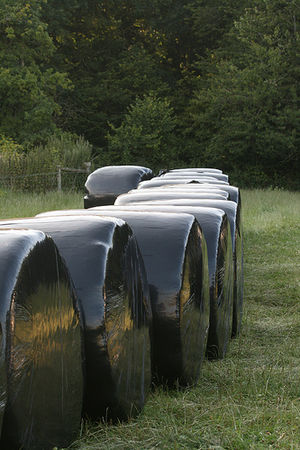Silage: Difference between revisions
Jump to navigation
Jump to search
(Created page with "300px|thumb|right|Bioplastics for silage bales 300px|thumb|right|Brick silo, but made of burned bricks, not CEBs Silage is the preser...") |
mNo edit summary |
||
| Line 2: | Line 2: | ||
[[File:silage04.jpg|300px|thumb|right|Brick silo, but made of burned bricks, not CEBs]] | [[File:silage04.jpg|300px|thumb|right|Brick silo, but made of burned bricks, not CEBs]] | ||
Silage is the preservation of green fodder in a silo by means of anaerobic fermentation. It relies largely on lactobacilli, especially ''Lactobacillus plantarum'' and is thus similar to the way in which Sauerkraut and Kimchi are | Silage is the preservation of green fodder in a silo by means of anaerobic fermentation. It relies largely on lactobacilli, especially ''Lactobacillus plantarum'' and is thus similar to the way in which Sauerkraut and Kimchi are preserved. | ||
==Advantages and Disadvantages== | ==Advantages and Disadvantages== | ||
'''Advantages:''' | |||
* weather at harvest time largely irrelevant <html><s>(make hay while the sun shines)</s></html> | * weather at harvest time largely irrelevant <html><s>(make hay while the sun shines)</s></html> | ||
* often better nutrient preservation than hay | * often has better nutrient preservation than hay | ||
* wide range of crops can be used (see below, "feedstocks") | * wide range of crops can be used (see below, "feedstocks") | ||
* weedy harvest can be used | * weedy harvest can be used, get rid of weed seeds in the process | ||
* large quantity of storage, for years | * large quantity of storage, keeps for years | ||
* no need for further processing | * no need for further processing | ||
'''Disadvantages:''' | |||
* harvest is heavier than hay, meaning higher initial energy input is required (then again, hay has to be dried, meaning turned) | * harvest is heavier than hay, meaning higher initial energy input is required (then again, hay has to be dried, meaning turned) | ||
* high weight and water content also means that silage cannot be transported very far, therefore low commercial value | |||
* equipment may be more expensive than that used for hay | * equipment may be more expensive than that used for hay | ||
* infrastructure for storage may have to be built (silo) | * infrastructure for storage may have to be built (silo) | ||
* when plastic sheets are used, there will be plastic waste that has to be recycled | * when plastic sheets are used, there will be plastic waste that has to be recycled. | ||
* silage odor ! | * silage odor ! | ||
Revision as of 15:12, 19 January 2011
Silage is the preservation of green fodder in a silo by means of anaerobic fermentation. It relies largely on lactobacilli, especially Lactobacillus plantarum and is thus similar to the way in which Sauerkraut and Kimchi are preserved.
Advantages and Disadvantages
Advantages:
- weather at harvest time largely irrelevant
(make hay while the sun shines) - often has better nutrient preservation than hay
- wide range of crops can be used (see below, "feedstocks")
- weedy harvest can be used, get rid of weed seeds in the process
- large quantity of storage, keeps for years
- no need for further processing
Disadvantages:
- harvest is heavier than hay, meaning higher initial energy input is required (then again, hay has to be dried, meaning turned)
- high weight and water content also means that silage cannot be transported very far, therefore low commercial value
- equipment may be more expensive than that used for hay
- infrastructure for storage may have to be built (silo)
- when plastic sheets are used, there will be plastic waste that has to be recycled.
- silage odor !
Suitable feedstocks
grass crops, corn (maize), sorghum, cereals (wheat, oats), beans, clover, sunflowers, ...
Applications and Product Ecology
- use as livestock fodder for ruminants (cattle, goats, sheep)
- feedstock for anaerobic digester to make biogas (popular: corn silage)
- Bioplastics to make silage bales or silage tubes
- CEBs to build vertical silo
- (speculative, unproven:) is it possible to grow maggots on silage ? (applications for aquaculture and poultry)
- there is often a nitrogen-rich liquid that drains from larger silos. It can be used as liquid fertilizer, for example to grow duckweed.
Links
- Wikipedia: Silage



